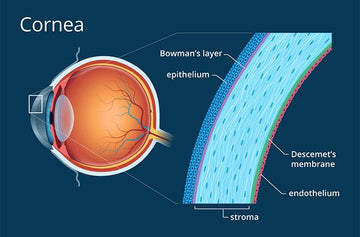
What is corneal erosion?
Corneal erosion occurs when the outer layer of the cornea, called the epithelium, does not properly attach to the underlying layers. This can cause the epithelium to detach, resulting in sudden pain, blurred vision, tearing, and sensitivity to light, often upon waking.
Why do corneal erosions occur?
The cornea, a clear, dome-shaped structure, protects the eye from particles and pathogens. The epithelium, the first layer of the cornea, is rich in nerve endings, which explains the intense pain felt during an erosion.
These erosions generally occur due to:
From an injury : Branches, cuts or other trauma.
-
Corneal dystrophies : Hereditary diseases affecting the structure of the cornea.
Other causes : Dry eyes, excessive eye rubbing, wearing poorly fitting lenses, etc.
Symptoms of corneal erosion
Sudden, severe pain.
Blurred vision.
Redness.
Watering eyes.
Increased sensitivity to light.
Recurrent corneal erosion syndrome
When erosion recurs, it is called recurrent corneal erosion syndrome . These recurrences can be triggered by minor injuries or dystrophies such as basal epithelial dystrophy (also called "map-dot-fingerprint dystrophy").
How is corneal erosion treated?
Treatment for corneal erosion depends on its underlying cause. An optometrist who suspects corneal erosion will ask if you have ever suffered a corneal injury. They will also look for signs of eye conditions that increase the risk of erosion.
When an optometrist examines a patient with corneal erosion, they may use an anesthetic drop to temporarily relieve pain and examine the eye more closely. A dye drop may also be applied to detect erosion. After a thorough evaluation, the optometrist may prescribe:
Antibiotic drops to prevent infection.
Pain relief medications , administered orally or locally.
Dilating drops for pain relief.
-
Debridement , a procedure performed by an ophthalmologist in Gatineau to even out the corneal surface to speed healing and reduce pain.
Bandage lenses to provide comfort and promote healing.
Preservative-free lubricating drops to moisturize and protect the cornea.
An eye patch to prevent further injury.
Prevention
Avoid rubbing your eyes.
Moisturize your eyes regularly with suitable drops.
See your optometrist for follow-up exams.